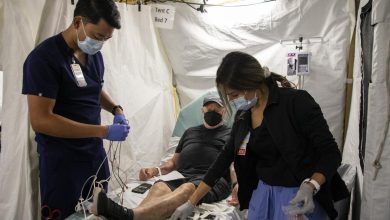New Menopause Pill Approved by FDA Targets Hot Flashes Safely and Naturally

Menopause marks a major transition in many women’s lives. While it is a natural phase, it is often accompanied by disruptive symptoms—among them, the notorious hot flashes and night sweats (together referred to medically as vasomotor symptoms, or VMS). Until now, many of the most effective treatments have been hormonal therapies. But for women who cannot take hormone replacement therapy (HRT) (for example due to a history of hormone-sensitive cancer or cardiovascular risk), options have been limited.
Now, a milestone has been reached: the Elinzanetant pill (brand name Lynkuet) has been approved by the U.S. Food and Drug Administration (FDA) as the first dual neurokinin 1 (NK1)/neurokinin 3 (NK3) receptor antagonist designed to treat moderate-to-severe vasomotor symptoms of menopause.
What Lynkuet is, how it works, why it matters, the clinical evidence and safety profile, how it fits into the treatment landscape, and practical considerations for women and their providers.
Understanding Menopause, Hot Flashes & Vasomotor Symptoms
Menopause is defined as the cessation of menstrual periods for 12 consecutive months, reflecting the end of ovarian function and the dramatic drop in estrogen and progesterone levels in a woman’s body. With those hormonal changes come a variety of symptoms — hot flashes, night sweats, mood changes, sleep disturbances, vaginal dryness, and more.
Hot flashes and night sweats—collectively called vasomotor symptoms (VMS)—are among the most common and disruptive: up to ~80 % of women undergoing the menopause transition report them. They can be more than just a bothersome symptom: they interfere with sleep, mood, productivity, relationships and quality of life.
Traditionally, the most effective treatment for VMS has been hormone replacement therapy (HRT; estrogen with or without progesterone). However, HRT is not appropriate for all women. For example, women with histories of hormone-sensitive cancers (e.g., breast cancer), thromboembolic disease, or certain cardiovascular profiles may be advised against HRT. This has left a significant unmet need for non-hormonal, effective therapies.
The New Pill: What Is Lynkuet™ (Elinzanetant)?
Lynkuet (elinzanetant) is a pill taken once daily at bedtime (soft-gel capsule, 60 mg) that works by blocking both NK1 and NK3 receptors in the brain. These receptors are part of the “Kisspeptin/Neurokinin B/Dynorphin (KNDy) neuron” system located in the hypothalamus, which plays a central role in thermoregulation (body-temperature control) and the generation of hot flashes when estrogen drops.
Simply put, by inhibiting NK1 and NK3 signalling, Lynkuet aims to calm the overactive thermoregulatory neurons that “mis-fire” when estrogen declines, thereby reducing the frequency and severity of hot flashes. Because it does not replace estrogen, it is non-hormonal, offering an alternative for women who cannot or prefer not to use hormonal therapies.
According to the manufacturer (Bayer AG), the approval of Lynkuet is supported by three Phase III trials (OASIS-1, OASIS-2 and OASIS-3) involving over 1,400 women.
Why This Matters — The Significance of a Non-Hormonal Hot Flash Pill
The approval of Lynkuet is a significant advance in women’s health for several reasons:
- Expands non-hormonal options: Until recently, non-hormonal options for hot flashes were limited (for example low-dose antidepressants, certain SSRIs/SNRIs) and often less effective with more side-effects. With Lynkuet, there is now a first-in-class non-hormonal pill whose mechanism is targeted specifically at the thermoregulatory system.
- Addresses unmet needs: Women who cannot take hormone therapy due to risk of breast cancer, cardiovascular disease, or osteoporosis may now have a stronger therapeutic option.
- Better sleep, better quality of life: In trials, Lynkuet not only reduced hot flashes but also improved sleep disturbances and overall quality of life — issues intimately tied to menopausal symptoms.
- First dual-NK1/NK3 approach: Previous approved non-hormonal treatment in this space was also neurokinin-based but only targeted NK3 (for example, Fezolinetant/VEOZAH). Lynkuet’s dual NK1/NK3 antagonism may offer broader symptom relief.
In short, this represents a paradigm shift: treating hot flashes not just symptomatically, but mechanistically, by targeting brain circuitry rather than replacing hormones.
Clinical Evidence: What Do the Trials Show?
The efficacy and safety of Lynkuet were demonstrated in the OASIS clinical trial programme:
- In the two pivotal 12-week randomized, double-blind, placebo-controlled studies (OASIS-1 & OASIS-2), involving ~800 women, Lynkuet significantly reduced the frequency and severity of moderate-to-severe vasomotor symptoms compared to placebo.
- A longer-term safety extension study (OASIS-3) followed 627 women for up to 52 weeks to evaluate longer-term tolerability and safety.
- According to manufacturer data: the co-primary endpoints were reduction in mean number of moderate or severe hot flashes and their severity from baseline to weeks 4 and 12. These were achieved.
- Importantly, improvements in sleep quality and overall menopausal quality of life were also observed.
Although detailed numerical data may vary, the results suggest clinically meaningful relief: fewer hot flashes, less intensity, and improved daily functioning.
Safety Profile and Considerations
As with any medication, safety and patient suitability are key. While Lynkuet is non-hormonal, it is not without risks or considerations. According to Bayer’s prescribing information:
Common side-effects include:
- Headache
- Fatigue/drowsiness
- Dizziness
- Abdominal pain or stomach discomfort
- Rash, diarrhea, muscle spasms
Important warnings/contraindications:
- Women who are pregnant should not take Lynkuet: there is a risk of pregnancy loss.
- People with a history of seizures may be at increased risk of seizure while taking Lynkuet.
- Lynkuet may increase liver enzymes — liver monitoring may be required. (For context, its predecessor fezolinetant had a FDA-added warning for rare but serious liver injury.
- Patients are advised to avoid grapefruit during treatment (due to potential drug-interaction).
So what does “safely and naturally” mean in this context?
- “Safely” indicates a favorable safety profile as evaluated in trials, and that Lynkuet offers relief without the typical risks of hormone therapy (e.g., estrogen-related concerns) for many women.
- “Naturally” in the sense that it does not administer hormones but targets an internal brain regulatory pathway (neurokinin receptors) that is part of the body’s own thermoregulatory system.
Nevertheless, “natural” should not be conflated with “risk-free” or with being suitable for everyone. A full medical evaluation is required.
How Lynkuet Fits into the Treatment Landscape
To understand the significance, it’s helpful to compare the options for menopausal vasomotor symptoms:
Hormone Replacement Therapy (HRT)
- Estrogen or estrogen + progestogen remains the gold-standard for many women. HRT effectively reduces hot flashes, prevents bone loss, and has beneficial effects on mood and sleep for many.
- However, HRT carries contraindications (e.g., certain cancers, thromboembolic disease) or concerns (depending on age, timing, individual risk).
- Some women simply do not want or cannot take hormonal therapy.
Non-hormonal options (prior to Lynkuet)
- Low-dose antidepressants (such as low-dose paroxetine) have been FDA-approved and used off-label for hot flashes. These have modest effect sizes relative to HRT.
- Other therapies: lifestyle adjustments (cooling strategies, avoiding triggers), behavioral therapies, alternative/complementary approaches (some evidence only)
- One previously approved targeted therapy: Fezolinetant (brand name VEOZAH) – the first NK3 receptor antagonist. It is non-hormonal, oral, and approved for moderate to severe VMS.
Where Lynkuet adds value
- It offers a new mechanism (NK1+NK3 antagonism) beyond NK3 alone, potentially broadening effect and improving outcomes (e.g., on sleep, mood, etc).
- It positions itself as a first-line non-hormonal pill for moderate to severe VMS in women who cannot or prefer not to use hormones.
- It may shift the treatment paradigm: less reliance on hormones; more reliance on targeted neuro-regulatory therapies.
Practical Implications: What Women & Providers Should Know
Who is a candidate?
- Post-menopausal women experiencing moderate to severe hot flashes and night sweats (vasomotor symptoms) that interfere with daily life.
- Women for whom hormone therapy is not suitable or is declined.
- Women who still want an effective option beyond lifestyle changes and older non-hormonal therapies.
Before starting Lynkuet, important steps include:
- A full assessment of medical history: underlying liver disease, seizure history, pregnancy status (though most post-menopausal women are not pregnant), other medications (for potential interactions).
- Baseline liver function tests may be required given the risk of elevated liver enzymes.
- Discussion of risks vs. benefits: While Lynkuet avoids estrogen, it still carries side-effects and requires monitoring.
- Review of lifestyle triggers and existing non-pharmacological strategies (e.g., reducing caffeine/alcohol, dressing in layers, keeping a cool environment, stress reduction, maintaining healthy weight) — these remain foundational.
- Timing: taking once daily at bedtime (with or without food) according to prescribing information.
During treatment:
- Monitor symptoms: frequency and severity of hot flashes, sleep quality, mood, daily functioning.
- Monitor side-effects: fatigue, headache, dizziness, abdominal pain, rash, etc.
- Monitor liver function (as per prescribing information).
- Reassess periodically whether the treatment remains necessary, whether dose or duration needs adjustment, and whether non-pharmacologic strategies should be maintained.
Duration of therapy
- While HRT guidelines often stress lowest effective dose for shortest time consistent with goals, the optimal duration of Lynkuet remains to be clarified in real-world practice.
- Since Lynkuet is non-hormonal, some clinicians may feel more comfortable with longer duration, but patient-specific risk/benefit must always guide treatment.
Cost and access
- As with many new therapies, cost and insurance coverage will be important considerations. Manufacturers often provide savings/support programs — women should check for access options.
- Accessibility and provider awareness will impact how widely it is adopted.
“Naturally” — A Closer Look at What That Means
The term “naturally” in the title should be interpreted carefully:
- It does not mean “herbal” or “unregulated” — Lynkuet is a regulated, prescription medication approved by the FDA.
- It does mean that the mechanism harnesses the body’s natural thermoregulation pathway (via neurokinin receptors) rather than delivering exogenous hormones.
- From a patient-perspective, some may prefer a non-hormone approach for this reason (e.g., less concern about estrogen exposure, less hormonal fluctuation).
- However, “natural” should not be taken to mean “risk-free” — all medications carry some risk and must be used under medical supervision.
Strengths, Limitations and Questions Still to Be Answered
Strengths
- Targeted mechanism: addresses the root neural driver of hot flashes rather than just masking symptoms.
- Non-hormonal: valuable for women with contraindications to hormone therapy.
- Evidence base: solid Phase III trials demonstrating meaningful symptom reduction and quality of life improvements.
Limitations / caveats
- Because this is a new therapy, long-term real-world data are limited (though the OASIS-3 52-week data gives some reassurance).
- Safety monitoring (especially liver function) is required — some women may prefer treatments requiring less monitoring.
- The cost burden (particularly for uninsured or under-insured patients) may limit uptake initially.
- It may not be appropriate for every woman; individualized care remains essential.
Still to be clarified
- How Lynkuet compares head-to-head with other treatments (HRT, NK3-only agents, SSRIs/SNRIs) in head-to-head trials.
- Long-term benefits beyond VMS (for example effects on sleep architecture, mood, cognitive function, bone health) remain to be explored further.
- Optimal duration of therapy, strategies for discontinuation, switching or combining therapies.
- Real-world safety data (especially in diverse populations, with multiple comorbidities).
- Global access and cost-effectiveness analyses.
Practical Tips for Women Considering This Option
Here are some practical tips for women (and their healthcare providers) considering Lynkuet as part of their menopause management:
- Keep a symptom diary: Track frequency of hot flashes, severity, night sweats, sleep disruption, mood changes, etc. This helps baseline evaluation and monitoring of treatment results.
- Discuss hormonal vs non-hormonal options: Even if hormone therapy is viable, some women may prefer non-hormonal; conversely, some may still prefer hormones. Shared decision-making is key.
- Optimize lifestyle first: While prescribing medications is valid, don’t overlook lifestyle measures (cooling strategies, avoiding triggers, maintaining healthy weight, managing stress, optimizing sleep hygiene). These complement any pharmacologic therapy.
- Set realistic expectations: Many women see meaningful reductions in hot flashes within weeks — in Lynkuet trials, symptom reduction began early and improved over 12 weeks. But not every case will be completely eliminated; “reduction” is a more realistic goal.
- Monitor and follow up: Regular follow-up is essential — to track efficacy, side-effects, and decide on continued therapy or adjustment.
- Consider costs and insurance: Ask your provider or pharmacist about assistance programs and whether your insurance covers Lynkuet.
- Discuss broader health goals: Hot flashes are just one facet of menopause. Bone health, cardiovascular health, urogenital symptoms, mental well-being all matter. A holistic approach to menopausal health is best.
Concluding Thoughts
For millions of women, the menopause transition brings not only hot flashes and night sweats, but disruption of sleep, mood, productivity and quality of life. The approval of Lynkuet (elinzanetant) offers a major new tool in the therapeutic arsenal: a non-hormonal, targeted pill that acts on the neural pathways driving hot flashes, improving symptoms and return to daily life for many.
While it is not a panacea and requires monitoring and individualized decision-making, it represents a meaningful advance: safer for many women who cannot or will not take hormones, and yet effective in reducing the burden of vasomotor symptoms.
If you are experiencing moderate to severe hot flashes and night sweats and are seeking a non-hormonal route, I encourage you to talk with your healthcare provider about whether Lynkuet may be an appropriate option — and to discuss how it might fit into a broader strategy of menopausal health (including lifestyle, sleep hygiene, cardiovascular and bone health).
Menopause is not simply a condition to endure — with evolving science and new therapies, it can be managed more thoughtfully and effectively than ever before. The advent of Lynkuet ushers in a new chapter in menopause care — one in which non-hormonal, neuroscience-based treatment is viable and promising.




